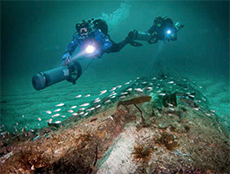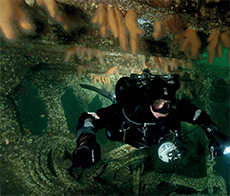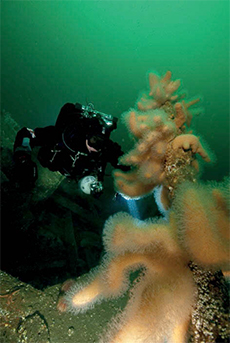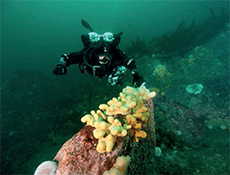




| Home | Features | Club Nights | Underwater Pics | Feedback | Non-Celebrity Diver | Events | 24 April 2024 |
| Blog | Archive | Medical FAQs | Competitions | Travel Offers | The Crew | Contact Us | MDC | LDC |

|

|
 
 |
    ISSUE 19 ARCHIVE - SHETLAND ISLANDSGareth LockWhere is it what lies approximately 600 miles north of London, is steeped in hundreds ofyears of history and is the resting place for 10s of wrecks lying in depths between 10m to 90m along with a vast array of wildlife both above the surface and below it? The answer isn't the Orkney Islands, but a set of islands a few (!) miles further north, the Shetland Islands. The excellent diving opportunities here are now being realised as some of the hard-boat skippers traditionally based in Orkney are now exploring the wrecks, walls, reefs and wildlife around the main islands and are allowing divers to experience them too. For the last two years I have travelled to dive the wrecks, primarily, using MV Valkyrie as my base; the first time with Hellfins SAC and this last year with Eastbourne SAC plus a few additional guests who had flown in from the US. Shetland IslandsThe Shetland Islands are a group of approximately 100 islands lying just more than 100 miles north of John O'Groats and the line of 60N latitude runs through the southern main island. Being this far north means that you are closer to Bergen in Norway than you are to Edinburgh. Access to the islands can be via ferry from Aberdeen or Scrabster (routing through Stromness) or by flying into Kirkwall. Many of the boats have cylinders to hire and lead to borrow is a definite possibility. I took the overnight ferry from Aberdeen on the Saturday, arriving in Kirkwall on the Sunday. Sharing a car between four, the cost worked out at approximately £250 per head for the travel, including ferry, starting south of the M4. There are a number of dive operators providing liveaboards in addition to MV Valkyrie, including MV Invincible and MV Halton. The Scapa dive boats normally pick a period of approximately six weeks in the middle of the summer, making the most of the best weather, before returning to Scapa to finish the season. One thing to bear in mind however, is that even though the weather can be good topside, the water temperatures are still in the order of 10C, even in the shallows. MV ValkyrieWhilst a number of the readership already know about the excellent service provide by Hazel and Helen on MV Valkyrie, it might be worth pointing out that the boat is run with safety as one of the highest priorities and is probably the best equipped boat in Scapa in this context. I should also warn you that due to the quality and quantity of the home-made food cooked by Helen, you are more than likely to come back at least a stone heavier than when you arrived! The boat is equipped to handle 12 passengers with twin bunk- beds in all of the cabins. There are two showers, a communal area with large TV and music system and a combined galley and dining area where Helen serves her amazing culinary creations! Whilst she doesn't handle the shellfish that the divers may catch, due to having a nasty reaction, she does prepare food from their deer stock, so venison-based food appears regularly. One of the more memorable meals I remember after we identified a wreck was champagne with scallops and lobster followed by venison pie! Wrecks and PhotographyMy main interest is cold water wreck photography using a technique called Close Focus Wide Angle whereby I use a very wide angle lens (normally 10mm) with the foreground subjects illuminated by a pair of strobes and the background lit by natural light. The aim being to balance the intensity of the light so the scene looks natural and the colours of the near Shetland provides excellent opportunities to do this sort of diving with a multitude of wrecks covered with sea-life and flora, so even those who are not interested in the wrecks themselves, will be kept interested by the non-metallic subjects under the water. The article will cover five of the most interesting wrecks to me, but there are tens more just waiting to be explored. GwladmenaThe Gwladmena was originally built in 1878 and launched as the SS Maggie Warrington. She was nearly 930 gross tonnes, 67m long, had a beam of 9m and draught of 5m. She was powered by a 2 cylinder compound steam engine which was fed by two large steam boilers. In 1918, she was laden with a cargo of coal en-route to Norway and sank after SS Flora collided with her as she was moored up. Gwladmena now lies in 38m with the top around 31m. The remains of the ship are lovely and make a classic UK wreck dive, albeit at the limits of recognised narcosis limits for air diving. The majority of the wreck is open and it is possible to dive into the forward locker areas in the bow section and explore these areas which are quite atmospheric and well lit. Moving aft you can see where the wreck has been wire swept to reduce hazards to shipping, and then you come across the 2 large boilers with the engine lying in front of them. This is not a normal configuration and is a consequence of the wire sweep. Moving further aft you can see the propellor shaft and then finally the stern. SS GlenIslaThe SS Glenisla was launched in 1878. She was 76m long, a little over 9m in beam and had a draught of just over 6m. She was an iron steam ship powered by two scylinder compound engines fed by three boilers. She sank on 24 November 1917 when she collided with SS Glenelg. Fortunately all 23 crew, including the captain were rescued. I have dived this wreck twice now and it is a classic. It lies upright in approximately 45m with a huge anchor lying off the starboard bow. Following the bow up and over the top, the diver is able to stay inside the bounds of the wreck passing the boilers and engines by swimming through incomplete overhangs of the original structure. There are many features which are intact including the tool locker complete with tools hanging in place. As you move to the aft section, you may note some wedges of ‘cheese' lying on the collapsed sections of the wreck - this is not cheese, but phosphorous, so please leave it on the wreck. If you bring it up, the skipper will not be best pleased! Lying off the port side on the seabed behind the stern, which is missing its propellor, is a gun placement mounted on a tripod structure. Unfortunately this also appears to be a place where the currents drop the detritus of human kind and there is a significant amount of litter around this section. Both times I have dived this wreck the visibility has been in the order of 15-20m which is not that unusual for Shetland. The wreck lies in the approaches to Lerwick harbour, so dive times can be impacted by harbour traffic. MV Fraoch BanThe Fraoch Ban is a little 15m trawler which sank in 1999 when her load of sand eels slopped around the inside and caused her to capsize. Although the boat sank in a few minutes, all four crew were saved. She lies on a white sandy seabed at 30m. This white sandy bottom means any light present is reflected back. The first time I dived the Fraoch Ban we jumped in and swam over to the shotline and put our heads underwater to start the dive. As we looked down, we could see the complete wreck lying on the seabed 30m down. We knew it was going to be a good dive. She is a little small for a whole boatload of divers, but because of the clear waters and plentiful light, it did provide for some excellent photo opportunities, especially the radio room, the small hold and the nets still in place at the stern. The second time the visibility was a little worse, this time, only 20m. The wreck provides a haven for lots of marine life in the area with shoaling fish and dead mens fingers adorning it. I am sure there are lots of small critters such as nudibranchs for those interested in that sort of diving and photography! Even though the wreck is in 30m, it is quite small which means that single tank divers can still manage 25-30mins before reaching their minimum gas limits. Noss Head, which is the closest point of land from the Fraoch Ban, is one of the largest seabird nesting sites in the UK which provides an interesting opportunity to view seabirds diving while you are underwater. As one of the group found out, the SOLAS tape on the back of their hood looks very much like a small fish as they were dive bombed by a gannet! E49The E49 was an E-class submarine built in 1916. She is 55m long with a 7m beam and displaced more than 650 tonnes. She had a pair of twin diesel engines which allowed her to cruise at 15kts on the surface and 10kts submerged. She sunk on 12 March 1917 when she struck mines laid by the German submarine UC76. Unfortunately she was lost with all hands. She lies in 30m, on her port side, with the bows blown off and separated by a few metres further off the port side. The wreck is a protected wreck site so please treat it with the respect due. Like the Fraoch Ban, the E49 lies on a white sand seabed but rather than an hour or so steam from Lerwick, she lies a considerable distance to the north which means that this day entails plenty of time underway. The one time I dived this wreck the visibility was in the order of 20m. This does allow the wreck to be viewed as a whole during the descent giving the diver the opportunity to orientate themselves as to what is where. The wreck lies partially covered, sunk into the sand, in an upright position. The attack periscope is still intact with its optics in place on top of the conning tower which has fallen over to the port side of the submarine. The bow section is open and inside you can see some of the mechanical and engineering structure of the wreck. As you move aft, you can see the top of the aft section just protruding from the sand, maybe 3ft proud. Much of the metalwork skin has now rusted away, leaving the more substantial framework visible. As you get right to the stern, you can see the hydroplane guards lying less than 12in above the surface of the sand. Whilst the wreck is a long steam from Lerwick, it is another 'must see' dive if you are visiting the Shetland Islands. Travelling to the E49 also means you get to see the stunning scenery as you pass through the archipelago of the Shetland Islands. SS JaneThe SS Jane was built in 1870 in Hartlepool. She was 60m long, a beam of nearly 9m and a draft of nearly 5m. She weighed nearly 850 gross tonnes. On 19 July 1923 she ran aground but managed to refloat on the next tide. Unfortunately she now had no means to steer and again grounded but this time was now seriously holed. She sank quickly with no loss of life. This wreck is an ideal choice of sites to dive either on the way to, or the way back from, the E49. However, because of where she lies, she is very susceptible to the tidal effects. Our dive started on the bow section and we gradually worked our way aft, entering various sections and exploring areas which looked promising for penetration (with line). There were also some fantastic photo opportunities afforded on this wreck including the rudders and propellor. We finally made the stern as the tide turned and within minutes the current had picked up such that we were unable to remain on the wreck. Rather than end the dive now, we decided to turn the dive into a drift dive and let the dSMBs ascend before we left the wreck so Hazel would know where we were. After about 5mins of interesting sub-surface scenery, the interest levels dwindled and we started our ascent to the surface. The Shetland Islands provide an ideal opportunity to experience cold water diving with a variety of wrecks and sea life. Whilst the weather can be rather hit and miss given its location as the furthest north main part of the United Kingdom, the dive sites are spread around the islands which means that you can dive pretty much every day as there is always somewhere to hide. The wrecks listed here are just a few of the huge number of wrecks littering the seabed around the Shetland Islands. There are plenty of others still waiting to be discovered if you want to try your luck on some marks which the skippers have... For those not quite so adventurous, there are sites which have life and some great photo opportunities. Have fun in the land of the midnight sun... |